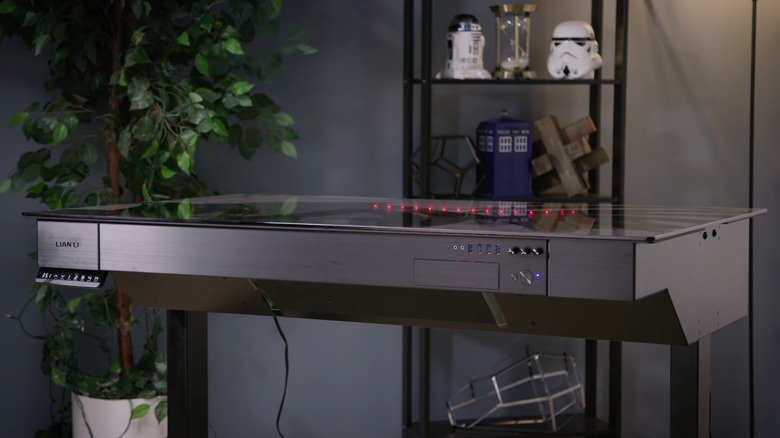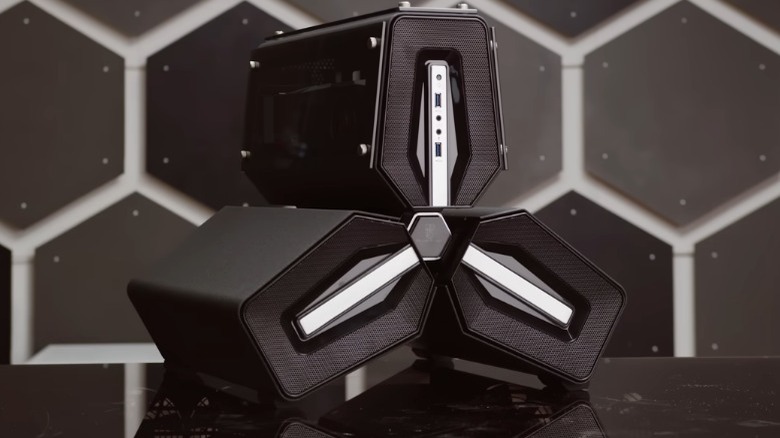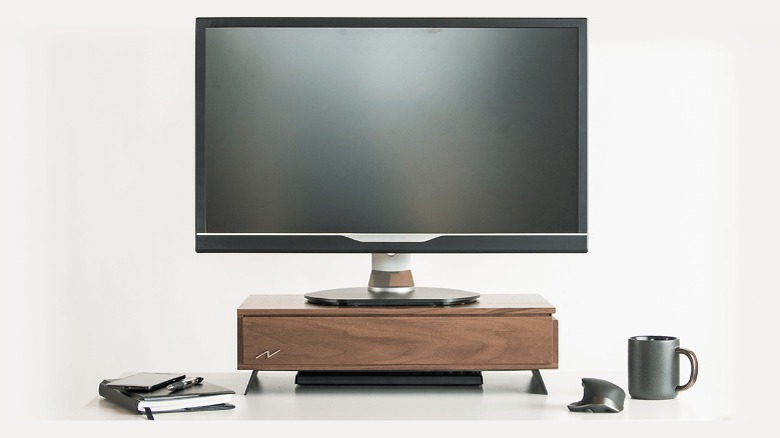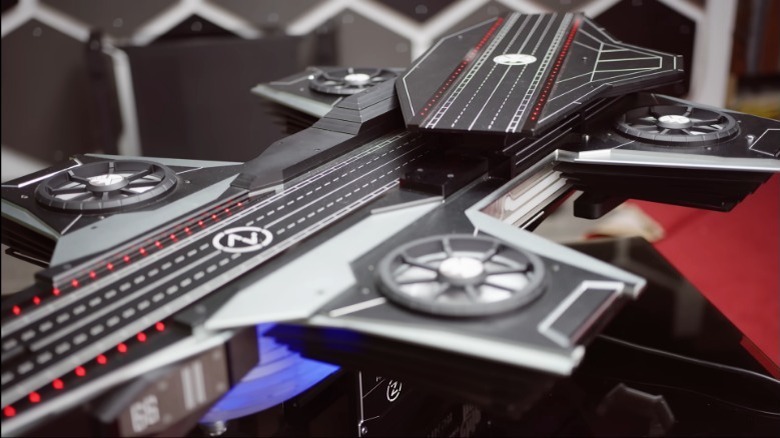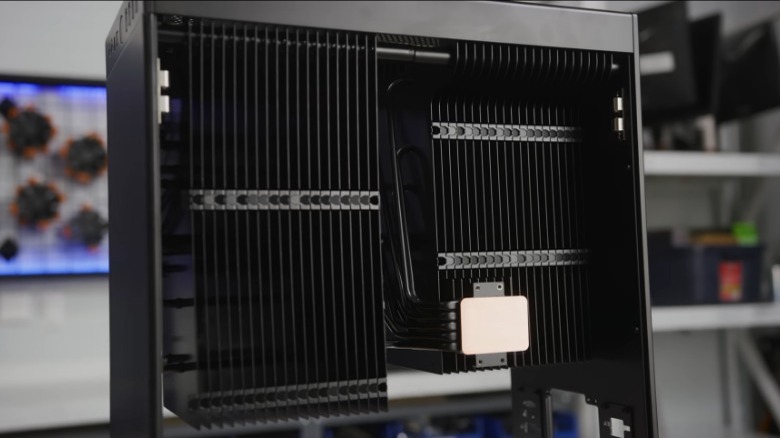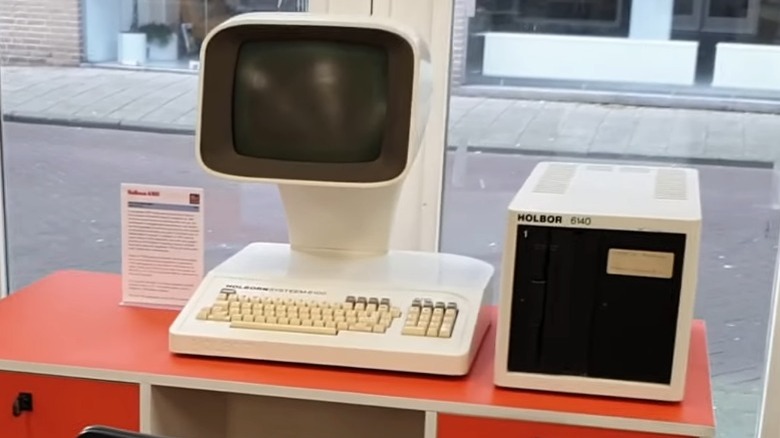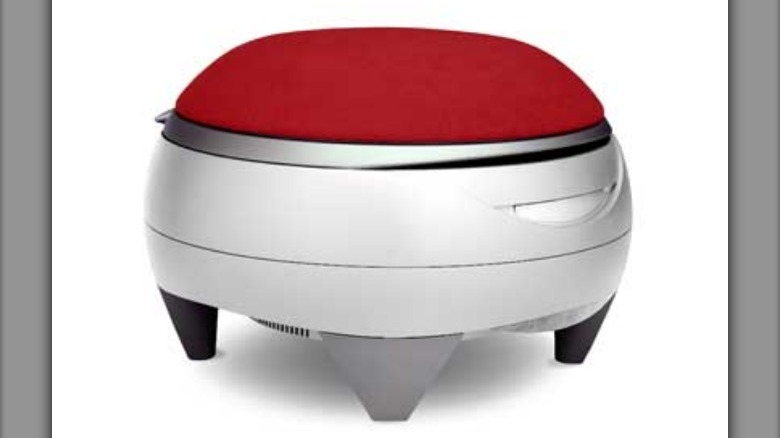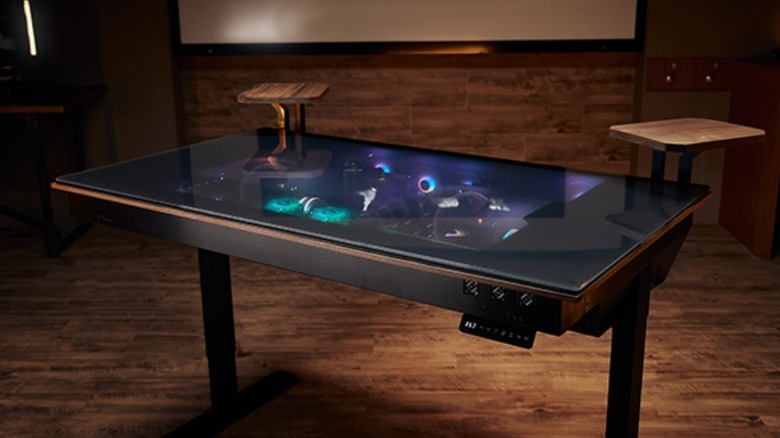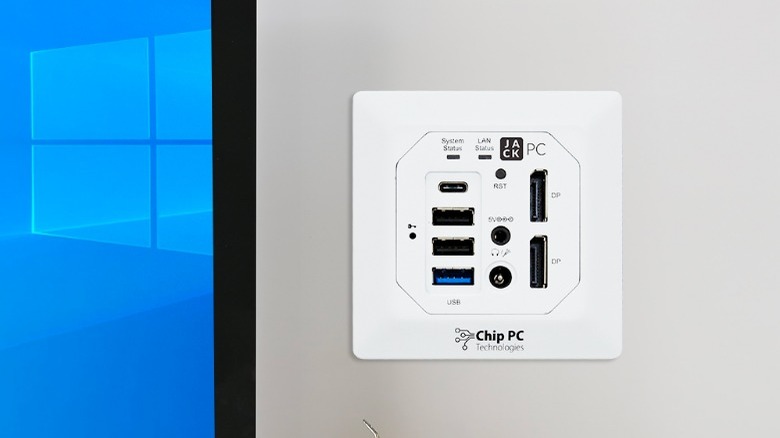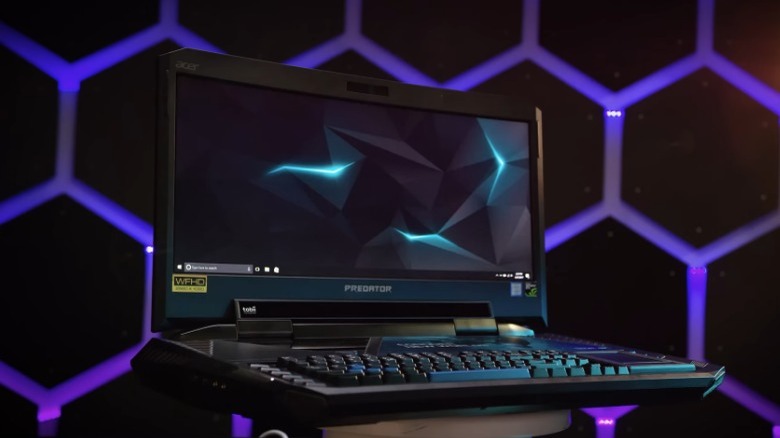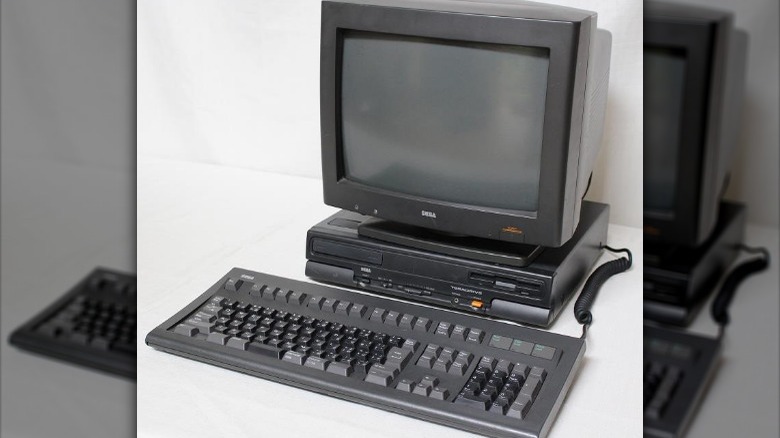The 10 Most Bizarre Desktop PCs Ever Designed
Half the fun of owning a desktop PC is admiring it. Sure, a PC doesn't need to look sleek to be a workhorse. You could purchase a stock computer, and there's nothing wrong with that, but when it comes to desktops, If you got it, flaunt it. And boy, do some computer designers let PC owners flaunt it.
Many PC manufacturers offer strange and downright eccentric computer cases, as well as pre-built desktops. Usually, these are a variation of a box or cube enhanced with sci-fi highlights and greebles, but some are designed by individuals who like to ask questions such as "Why can't I make a case look like a fish?" or, "Who says I need a fan or liquid cooling system for my PC?" The cases — and occasionally full-blown PCs — these designers develop tow the line between eccentricity and insanity in the best way possible, but while many are weird and unusual, a few are truly bizarre.
Multi-chamber PCs
Most PC cases follow one simple rule: Cram all the components, wires, and cooling systems into one space while making sure they have enough room to breathe. It's a simple design, but is it really the most efficient one? Some manufacturers don't think so.
The DeepCool Tristellar looks less like a computer case and more like the footprint of a sci-fi robot. Instead of using a main cavity to store all the components, this unique case is divided into three chambers: One for the GPU and SSD, one for the power supply and hard drive, and one for the motherboard and cooling system. Theoretically, this compartmentalized design improves airflow and keeps the components cooler. In practice, the Tristellar creates quite the setpiece. The custom PC company CyberPowerPC was so smitten with the unique, tridactyl design that it used the Tristeller for its Trinity Xtreme line of PCs. But why stop with three chambers when you can have four?
DeepCool built upon the success of its Tristellar to produce the Quadstellar, which added one more chamber to make the case like the footprint of an Imperial AT-AT — and give PC builders more room to work with. Thanks to the additional chamber, the Quadstellar can fit more and more powerful components without sacrificing cooling, and it even came with an app that let users control its RGB lighting and extendable front flaps. Unfortunately, DeepCool has discontinued support for the app.
CDO Volta V
PC cases are, more often than not, mass produced items built out of materials that are easy to manufacture quickly and in mass quantities. Metals such as steel and aluminum make for the best cases, with the occasional bit of tempered glass so PC owners can admire all their expensive components with RGB lighting. But CDO Technologies had a different plan.
Instead of producing computers out of inorganic materials, CDO Technologies had the green idea of selling the world's only wooden desktops. The Volta V is a small-form PC that comes in a case made out of walnut paneling — or bamboo if you are willing to pay extra. The internals aren't wooden, though. Moreover, The Volta V is designed to stay as cool as possible because the last thing anyone wants is for their $2,000+ wooden PC to go up in smoke.
While the Volta V looks like a piece of modern furniture, customers can deck it out with a variety of CPUs, GPUs, and hard drives for any computing task, including gaming, or at least they could. The COVID-19 pandemic forced CDO Technologies to close its doors, so while the website is still up (but not for everyone), you can't purchase any of the computers, including the Volta V. You can still check out their specs and marvel at their gorgeous wooden designs, but the "Customize & Buy" buttons don't work.
Vehicle-shaped PCs
Odds are you have seen at least one custom PC mod case. These one-of-a-kind designs can look like literally anything. Modders have created cases that mimic shoes, apartment buildings, and even a 1:1 replica of the Iron Man suit. Some PC manufacturers do the impossible and make PCs shaped like real objects, and others one-up their contemporaries by producing cases shaped like sci-fi vehicles.
Arguably the weirdest (and most beautiful) vehicle-themed computer case is the Zadak 511 Helicarrier. This production model, produced by Zadak, is inspired by the iconic S.H.I.E.L.D. Helicarrier and is packed to the turbines with features. According to the few who got their hands on one (such as Linus Tech Tips), this marvelous monstrosity comes with an Intel Core i7-6950X CPU, an NVIDIA GTX 1080 GPU, and 32GB of RAM, as well as a liquid cooling system and RGB lighting. Zadak also completed the illusion by including some toy jets and replacing the power button with a capacitive strip along the runway. The result is a setpiece PC too heavy for one person to carry.
Since the Zadak 511 Helicarrier is so big, heavy, and powerful, it features a price tag to match. At the time of Linus' video, the PC cost 129,999 Chinese Yuan, or about $20,000. Several years ago, Lenovo announced its plans for the Tiburn, a PC shaped like the U.S.S. Enterprise from "Star Trek." No word on its price or release date, but the computer will come with a built-in projector.
MonsterLabo's The Beast
Computers usually rely on one of two cooling systems: fans or water cooling. Each has its own pros and cons, but without them, computer components would generate so much heat they would literally cook themselves. Some designers figured out how to keep computers cool and fire-free without any moving parts. All you need is the right case.
At first glance, MonsterLabo's The Beast case looks downright plain, especially compared to other PCs on this list, but as the old adage goes, it's not what is outside but what's inside that counts. Inside The Beast rests two 6.6 lb heatsinks. These gargantuan components work in tandem with 20 heat pipes and six thermal drains to passively cool the PC's CPU and GPU, all while minimizing noise. Of course, since each heatsink weighs as much as a two-and-a-half MacBooks, The Beast is far bulkier and heavier than most rival cases.
Understandably, many potential users are concerned about the efficacy of two beastly heatsinks, but YouTubers such as Optimum Tech and Linus Tech Tips tested The Beast and found it worked as promised. The case and its heatsinks kept all but the most expensive and overpowered components cool, all while the bombastic noise of gaming overpowered the barely perceptible hum of electricity. While MonsterLabo's The Beast is arguably the best fanless case on the market, it isn't the only one. Companies such as SilentPC and Streacom also offer their own passively-cooled PCs.
The Holborn 9100s
When you think about bizarre PCs, your mind likely wanders to recent products. After all, computers have only been widely accessible for a relatively short amount of time, so audiences could only customize them during that period. But back when computers started shrinking and no longer took up entire rooms, designers drafted some weird designs to make them look appealing.
The Holborn 9100 series of computers was a collection of office PCs designed by the Dutch company Holborn. Essentially, each Holborn 9100 "computer" was actually a bunch of terminals, the Holborn 9120, networked into a main server the size of a mini fridge, the Holborn 9100 proper. These computers were designed for use in office spaces. Holborn also produced several other models, such as the Holborn 7100 and the Holborn 6500, which were cheaper and sometimes even standalone PCs. So far, sounds like standard stuff, at least until you look at the monitor.
The screens of the Holborn line were nothing if not unique. Each was connected to the terminal or computer by what can only be described as a sci-fi cruise ship funnel. The Holborn computers looked like they were imagined by a game designer aiming for retro-futurism (i.e., how people in the past thought the future would look), except it really was designed by someone trying to envision the future. At least, we think it was.
Intel Ottoman PC
Computers are today an everyday sight in the household. In fact, many homes don't look complete without a PC workstation. But once upon a time, home computers were rare and designers brainstormed ways to camouflage them. One idea seemingly took inspiration from the "Transformers" cartoon.
In 1999, Intel unveiled its concept for a computer that would be at home in any room: the Ottoman PC. Developed in collaboration with Sozo Design, the computer's name wasn't just a label; it was literally a PC with a screen that folded down to form an ottoman, complete with a cushioned top. The computer came with a removable wireless mouse and keyboard that was stored inside its body, so when it was in ottoman mode, guests would be none the wiser unless they spied its conspicuous handle and hinges.
Why would Intel want to create such an unusual computer? According to product descriptions, it was supposed to blend in with the rest of a family's furniture when not in use. For whatever reason, the product never caught on and was never mass-produced, but its spirit lives on in other products. For instance, the Predator Thronos is a gaming PC, display studio, chair, and back massager (seriously) all rolled into one. Sure the Thronos is far more expensive than the Ottoman probably would have been, but you have to admit a computer that cushions your entire body is a bit more enticing than one that only supports your feet.
Desk PCs
Desktops are, by definition, large computers designed to sit on or under a desk. The more powerful a desktop, the more space it inevitably takes up, but what if you could kill two birds with one stone and build a PC that is gargantuan but took up no space on or below your desk? Sounds like a paradox, but it's 100% real.
The Lian Li DK-05F and Hydra Desk are two takes on the same idea: a desktop case that serves double duty as a desk. Both let users customize their PCs by inserting whatever compatible components they want, including motherboards, CPUs, GPUs, and hard drives. Plus, each desk includes a tempered glass top so owners can admire their builds. While Hydra only makes one desk, Lian Li also offers the smaller and less expensive DK-04F.
One might assume the Lian Li DK-05F and Hydra Desk are just cases that mimic the shapes and basic functions of desks, but they are designed with ergonomics in mind. The Li Lian DK-05F even comes with adjustable legs to fit users of virtually every height — and help them avoid supper-crossed syndrome. Plus, the desktop desk is sturdy enough to support up to 176 lbs, so users are free to decorate it however they want. Since the Lian Li DK-05F and Hydra Desk are unique desktop/desk hybrids, they are understandably expensive. But nobody said building PCs was a budget-friendly hobby.
Jack PC
Virtually every modern computer needs an internet connection. Not only is this "always online" design useful for staying up to date with the news, it lets software developers keep users up to date with the latest patches and fixes. But you usually need to either physically connect a desktop to a modem and connect that to the ethernet port, or you connect a router to your modem and then use wi-fi. One computer manufacturer decided to cut out the middleman.
The Jack PC is one of the most space-efficient desktops on the market. This "desktop" is so small it can literally fit in a wall LAN jack, hence its on-the-nose name. How the designers at Chip PC managed to fit everything into a case the size of a wall socket is nothing short of wizardry, but the computer still has all the USB, display, and audio ports of its bigger brethren.
Now since the Jack PC sits snugly in the wall, one can't help but wonder how the device receives enough power to fuel its processes. Well, therein lies even more of this desktop's magic: It receives all the juice it needs directly from the ethernet. This design choice lets users save a bundle on their electricity bill, but it has some drawbacks. While the Jack PC is modular, its very design limits its functionality. Owners can use the desktop for everyday office work, but playing virtually any game newer than the 1993 original "DOOM" is probably impossible.
Laptops in Name Only
Unlike desktops, laptops are designed to be portable. Thanks to ever-improving (and shrinking) technology, many laptops, including gaming laptops, can match or even outperform desktops, often at the cost of size. Put too much in a laptop, and it ceases to become one.
The Acer Predator 21X and the ASUS ROG GX700 (and by extension GX800) are two laptops that are essentially desktops with folding lid screens. The Acer Predator 21X, for instance, is a 21-inch behemoth with a mechanical keyboard, two GPUs, a trackpad that flips over to form a numpad, and even a built-in Tobii eye-tracker. To fuel the Predator 21X's components, the "laptop" requires two power bricks, and its battery lasts less than one hour. All of the computer's components come to a total of 19 pounds, which essentially limits it to a permanent spot on gamers' desks.
The ASUS ROG GX line, meanwhile, is among the gaming world's few liquid-cooled laptops. These computers are hefty 18-inch laptops with two GPUs, but to push the computers beyond their limits, users need to plug them into detachable "Hydro Overclocking System" docks. These docks aren't necessary for everyday use but are a vital piece of the ROG GX gaming experience and make the laptops less portable than even the ACER Predator 21X. Because of the dock's size and sensitive components, the ROG GX700 and 800 are best left at home since the only way to safely transport them is with a proprietary luggage case.
Sega/IBM Teradrive
These days, PC gamers have too many titles to play. Many modern games have been ported to PC, including what used to be PlayStation exclusives. Moreover, publishers have made many console-exclusive retro titles available on PC, but that is more of a recent development. Back in the days of cartridge gaming, the only way to play on PC was to use a desktop that came with a console cartridge slot. But who would make such a device? Sega.
The Teradrive was a unique hybrid PC from 1991 developed exclusively for Japanese markets. At first glance, the computer looked somewhat plain with its all-black finish, but what made it so unusual was its configuration. Unlike other IBM computers, the Teradrive featured a switch to toggle it into a Sega Mega Drive (the Sega Genesis to US gamers). By inserting a cartridge and controller into the left side of the computer, owners could play Sega games, but since the desktop was only released in Japan, it only accepted non-region-locked cartridges.
Since the Teradrive was a hybrid PC/Sega console, it could also function as a Sega software development kit. Some rumors claimed it was intended to function solely as one, but that was debunked. Unfortunately, the Teradrive proved unsuccessful, and Sega's planned add-ons were canceled when the PC was inevitably discontinued. Despite that fate, Sega tried again with the Amstrad Mega PC, another desktop/Sega Mega Drive hybrid, this time released in 1993 for PAL regions. This desktop was also unsuccessful.
